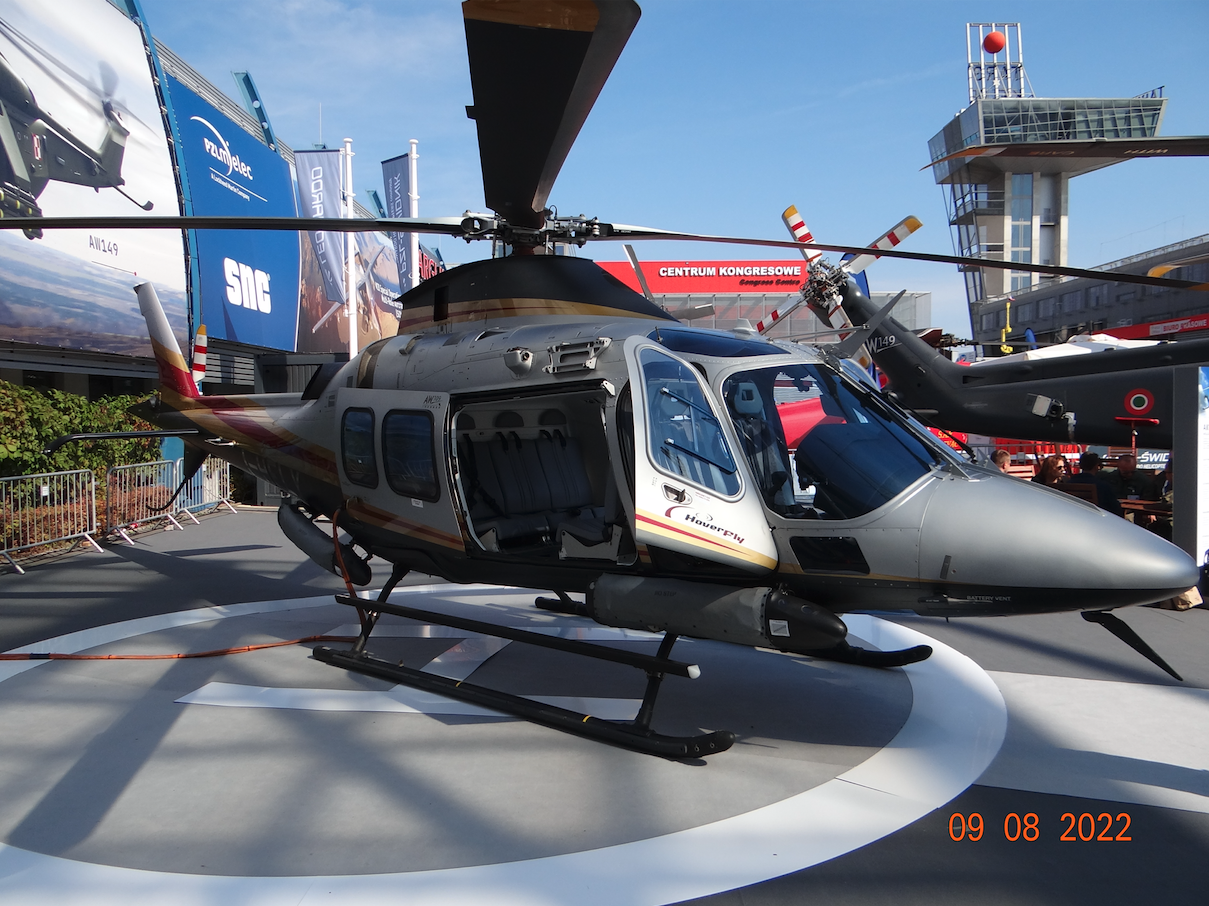Kraków 2006-09-10
AgustaWestland A.109 / AW.109.
Construction A.109 / AW.109.
Agusta A.109 is a light, two-engine, metal helicopter built in the classic Sikorsky layout.
The main rotor has 4 blades. The blades are articulated. The rotor blades can be manually folded for storage. The rotor is equipped with a brake. The rotor blades are made of metal: aluminum, steel and nickel. The tail rotor has 2 blades. The propeller is located on the left side of the tail boom. The main gearbox transfers the rotation from the two motors to the main rotor and the tail rotor. The main gear reduces the rotation speed for the main rotor 1: 15.26 and for the propeller 1: 2.88. The fuselage of the helicopter is made of aluminum and consists of 5 main components: nose part, cockpit, loading, rear part and tail beam.
The landing gear is three-legged, with a front wheel, with single wheels, retractable in flight. The landing gear retraction mechanism is hydraulic. Tubeless tires measure 306 x 135.6 mm, pressure 0.59 MPa. Some A.109 helicopters were equipped with an unwanted landing gear made as skids.
The A.109 helicopter has optional self-inflatable floats for emergency landing on the water. This system is produced by Garret Air Cruisers.
The helicopter is flown by two or one pilot. The helicopter cabin accommodates six passengers. Two rows of three seats each. The sanitary version takes on board two sick on a stretcher and two paramedics. The equipment includes a winch with a lifting capacity of 150 kg. The military version takes seven soldiers on board.
A large reserve of power and high impact resistance ensure the AW.109 maximum safety in all flight conditions. The airframe of the Trekker version is made entirely of aluminum alloy. The heavy-duty skid undercarriage and crew and passenger seats are the physical characteristics of crashworthiness. Other AW.109 helicopters have a wheeled undercarriage.
A.109 engines.
The A.109 helicopter is powered by two Allison 250-C20B turbine engines, manufactured in the USA. These engines are used in Bell Jet Ranger, MBB B0-105 and Hughes 500 helicopters.
Engine dimensions: length 1.946 m, width 0.483 m, height 0.572 m. Engine weight 71.5 kg. Take-off power 313 kW, nominal power 272 kW. The gas temperature in front of the turbine is 810 degrees Celsius. The oil installation has a volume of 7.7 liters. An alternative engine is the Turbomeca Arriel 1K engine with a starting power of 522 kW and a nominal power of 437 kW.
The main fuel tank is mounted at the rear of the fuselage. It has a capacity of 550 liters. In version A.109 K the capacity of the tank has been increased to 700 liters. In Agusta A.109 helicopters, it is possible to install additional internal fuel tanks.
Equipment A.109.
Electric installation with direct current and voltage of 28V. The helicopter has two alternators (30V / 150A) that are used to start the engines. Batteries (24V, 22Ah). The single-phase alternating current is obtained from three thyristor inverters (115 / 26V, 250Ah).
Avionics is assembled depending on the customer’s wishes. VHF / MF radio. UHF / MF radio. ILS system. Radio rangefinder DME. VOR system. ADF radiocompass. 4-channel automatic remote control. Vibration stabilization and damping system. Intercom. Radio or laser altimeter. Weather or other type radar. TV camera. Infrared camera. Glass cockpit (since 1995).
Data T-T Agusta A.109A:
Overall length 13.08 m (42.91 ft). Helicopter fuselage length 11.11 m (36.45 ft). Overall height 3.21 m (10.53 ft). Main rotor diameter 11.00 m (36.09 ft). Tail rotor diameter 2.03 m (6.66 ft). Tail span 2.88 m (9.45 ft). Chassis base 3.53 m (11.58 ft). Main landing gear width 2.45 m (8.04 ft). Cabin volume 2.83 m 3 (99.94 ft 3). Boot volume 0.52 m 3 (18.36 ft 3). Main rotor blade area 1.82 m2 (19.59 ft2). Propeller blade area 0.20 m2 (2.15 ft2). Main rotor drive wheel area 95 m 2 (1 022.57 ft 2). Propeller wheel area 3.21 m2 (34.55 ft2). Nominal take-off weight 1,415 kg (3,119.54 lb). Maximum take-off weight 2,600 kg (5,732.02 lb). Top speed 311 km / h (193.25 mph). Cruising speed of 266 km / h (165.28 mph). Rate of climb 488 m / min (8.13 m / s, 18.19 mph). Operating ceiling of 4,572 m (15,000 ft). Single engine operating ceiling 1,370 m (4,494.75 ft). Maximum range 615 km (382.14 mi, 332.07 nm). Flight time up to 3 hours 30 minutes.
Written by Karol Placha Hetman


